Astronomers combined observations of far distant galaxies exhibiting no signs of star formation and found active supermassive black holes that may have contributed to the evolution of their parent galaxies. Plus, rocket launches, detecting earthquakes, and why Uranus and Neptune are different shades of blue.
Podcast
Show Notes
Two human spaceflights launch on same day
- Blue Origin pre-launch press release
- Blue Origin post-launch press release
- CASC crewed launch press release (Chinese)
- CASC Geely press release (Chinese)
- Progress Cargo Craft Launches on Quick Station Trip (NASA)
Planetary defense exercise finds Apophis… Again
- NASA press release
- NASA JPL press release
- “Apophis Planetary Defense Campaign,” Vishnu Reddy et al., 2022 May 31, The Planetary Science Journal
The universe’s boring motion documented
- University of Colorado Boulder press release
- “The Universe is Brighter in the Direction of Our Motion: Galaxy Counts and Fluxes are Consistent with the CMB Dipole,” Jeremy Darling, 2022 May 26, The Astrophysical Journal Letters
Black holes suspected in galactic deaths
- NAOJ press release
- Subaru Telescope press release
- “COSMOS2020: Ubiquitous AGN Activity of Massive Quiescent Galaxies at 0 < z < 5 Revealed by X-Ray and Radio Stacking,” Kei Ito et al., 2022 April 12, The Astrophysical Journal
Improving earthquake measurements at light speed
- Monitoring Earthquakes at the Speed of Light (Eos)
- “Instantaneous tracking of earthquake growth with elastogravity signals,” Andrea Licciardi et al., 2022 May 11, Nature
Greening of the Alps seen from space
- University of Basel press release
- “From white to green: Snow cover loss and increased vegetation productivity in the European Alps,” Sabine B. Rumpf et al., 2022 June 2, Science
Two planets, both alike in iciness
- ESA Hubble press release
- NOIRLab press release
- “Hazy Blue Worlds: A Holistic Aerosol Model for Uranus and Neptune, Including Dark Spots,” P. G. J. Irwin et al., 2022 May 23, JGR Planets
Transcript
Something quite remarkable happened over the weekend.
All of the Starlink satellites spontaneously winked out of existence?
No, not that awesome. Two human spaceflights happened on the same day: New Shepard-21 and Shenzhou-14.
Okay, that’s impressive. And did you hear? Researchers have found active supermassive black holes in dying galaxies.
Huh. I’ll let you explain what that means. Hey, Beth is also back and bringing us a bunch of planetary science stories, including an asteroid detection exercise and why Uranus and Neptune are different colors.
Sounds like a great show.
Let’s get to all that and more, right here on the Daily Space.
I am your host Dr. Pamela Gay.
And I am your host Erik Madaus.
And we’re here to put science in your brain.
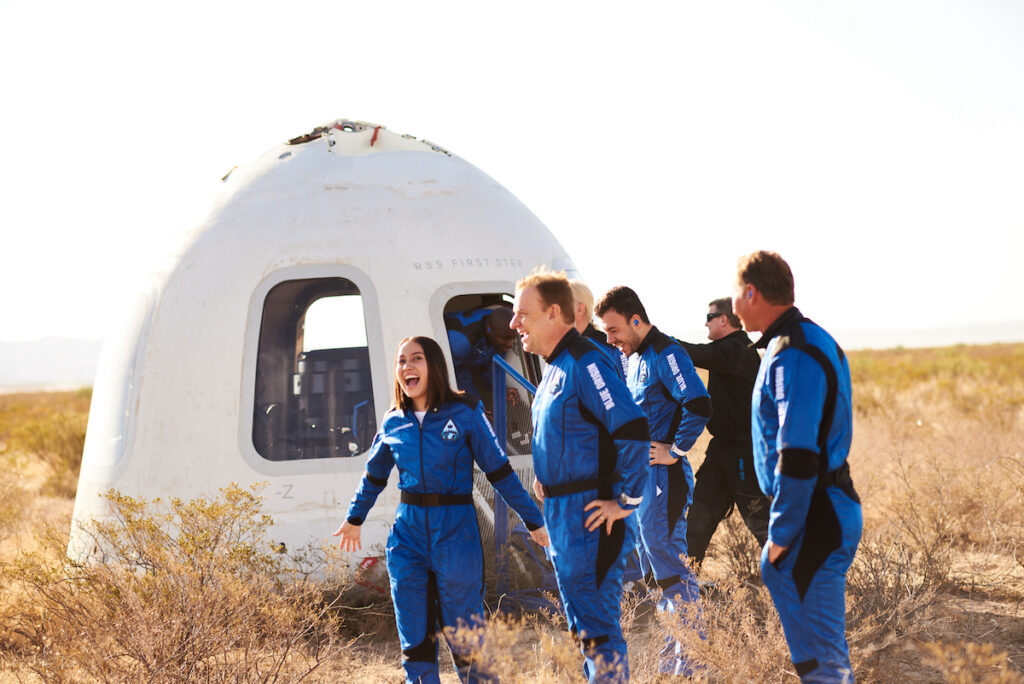
Over the weekend, there were several rocket launches, including two human spaceflights on the same day (local time). The last time this happened was back in 1975 with the Apollo-Soyuz Test Project.
The first crew to go up on Saturday, June 4, at 13:25 UTC, was the six members of New Shepard-21, the program’s fifth human spaceflight. One of the six spaceflight participants was Blue Origin’s first repeat customer, Evan Dick. He previously flew on New Shepard-19 in December 2021. Another crewmember of note is Katya Echazarreta, a former NASA engineer and the first Mexican-born woman to go to space. Her seat was bought by the nonprofit Space for Humanity.
Victor Hespanha is the second Brazilian in space; his seat was funded by the cryptocurrency organization Crypto Space Agency. There were also two investors on NS-21: Jaison Robinson, also a former contestant on the tv show Survivor, and Victor Vescovo.
NS-21 reached an altitude of 107 kilometers above mean sea level, with the booster reaching a slightly lower 106 kilometers above mean sea level. The total mission duration was ten minutes, twelve seconds. The flight was delayed from late May due to a vehicle issue.

Also on June 4, the China National Space Agency launched their Shenzhou-14 mission to Tiangong at 02:44 UTC on the fifth, which was 10:44 China time on the fourth. A couple of minutes later, the Long March 2F rocket successfully inserted the spacecraft into orbit. The crew was not officially revealed until hours before launch and consisted of Chen Dong, Liu Yang, and Cai Xuzhe. Chen and Liu have been into space before; Liu Yang became the first Chinese woman in space when she launched on Shenzhou-9 back in 2012.
Six and a half hours after launch, the spacecraft autonomously docked to Tiangong, and a few hours later, the crew entered the station. This crew has several big tasks ahead of them in their six-month mission: the integration of two lab modules, which will launch and dock later this year, the unloading of another cargo spacecraft Tianzhou-5, and the receiving of the next crew before they leave. This last event will set a milestone of six Chinese astronauts in space at one time on Tiangong. All of this work will also include a packed program of science, of course.
There were two more launches over the weekend. The first of those occurred on June 2 at 0400 UTC. A Long March 2C lifted off from Xichang with nine Geely Constellation-01 satellites. Geely is a Chinese car manufacturer that is building a satellite constellation for its future self-driving cars. This flight set a record for the most satellites launched by a Long March 2C.
Finally, the last launch this weekend was the latest Progress vehicle, MS-20, from Kazakhstan to the International Space Station (ISS). After a very fast three-hour rendezvous it docked, bringing 2.5 metric tons of supplies to the station.

It’s been a moment since we brought you news of a hazardous asteroid because, well, there aren’t any hazardous asteroids at the moment. Don’t let sensational clickbait headlines convince you otherwise. What we do have, however, is a neat story of how the global planetary defense community discovered asteroid Apophis… again.
Back in December 2020, the near-Earth asteroid Apophis began a close-ish approach to Earth, and as a test of our asteroid detection capabilities, this approach was used as an exercise. First, the Minor Planet Center basically wiped out the data from their surveys of all preexisting Apophis observations. This meant that other surveys couldn’t connect any new observations with those existing ones. For all intents and purposes, Apophis hadn’t been discovered, yet.
Now it was up to the various ground-based telescopes and surveys to do their jobs. And they succeeded beautifully. On December 4, 2020, the Catalina Sky Survey got the first detection, which turned up in their survey to be something new, of course. Then ATLAS and Pan-STARRS detected the “new” object. Next up, NASA’s NEOWISE captured observations from space, which were linked to all the ground-based observations and allowed scientists to see the object’s motion through the sky.
On December 23, the Minor Planet Center logged the object into the system as the confirmed discovery of a “new” near-Earth asteroid. And that was when all the calculations began. Scientists have detailed those results in a new paper in The Planetary Science Journal with lead author Vishnu Reddy, who notes: This real-world scientific input stress-tested the entire planetary defense response chain, from initial detection to orbit determination to measuring the asteroid’s physical characteristics and even determining if, and where, it might hit Earth.
The final piece of the puzzle for this test came when the Goldstone telescope took radar observations during March 2021 – the closest approach of Apophis – of the “new” object that allowed for precise measurements of the asteroid’s velocity and distance. And all of these calculations came together to refine the orbit of this potentially hazardous asteroid, which of course, turned out to not be an impact threat to Earth for at least 100 years, as we already knew about Apophis.
The system seems to work. Let’s hope we don’t have to test it anytime soon, though, since we don’t know if something like the Double Asteroid Redirection Test, or DART mission, will succeed in shifting an asteroid’s orbit.
We’ll be back with more planetary science later on in the show, but first, let’s go to Dr. Pamela and talk about black holes.
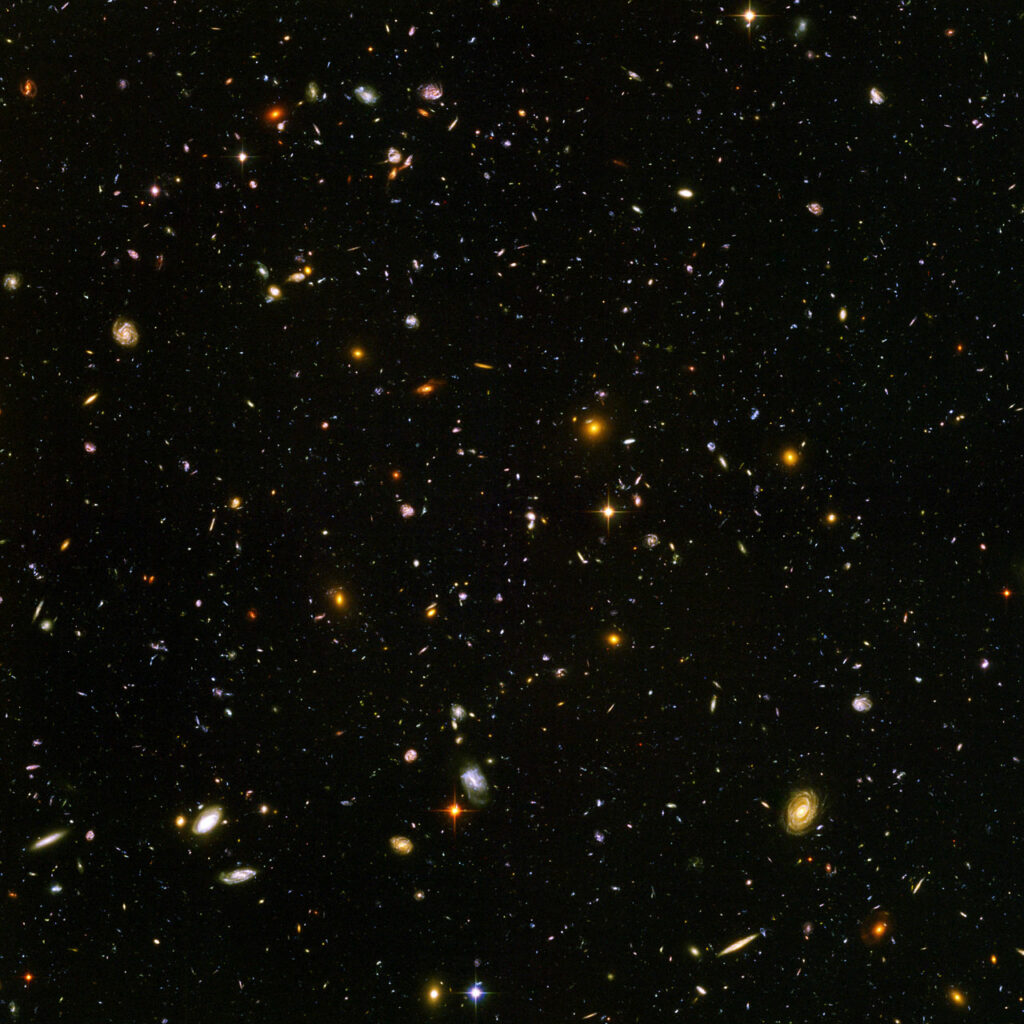
Trying to measure our place in space is one of those things astronomers have done many different times, and many of those different times, we’ve discovered weird stuff.
In 1914, Vesto Slipher measured our place relative to the motions of fifteen different galaxies. He expected that all the galaxies would be moving randomly compared to our own system, just milling around with nothing particularly unique going on. Instead, he discovered that the majority of galaxies are moving away from us. This seemed to imply that either we are in a unique place – centered in a group of galaxies that appear to be running from us – or, as Hubble would go on to explain, we are in an expanding universe.
In the 1960s, the cosmic microwave background (CMB) was discovered, and over the following years, we worked to measure our place relative to this background light. A motion of 368 kilometers per second was discovered, helping us confirm our galaxy’s motion as we fall toward the Virgo cluster, and also showing motion toward a great hidden cluster lost behind the light and dust of our Milky Way. Again — from the measured motions we learned new things.
As our equipment has improved, researchers have worked to refine our place in space, as well as the positions and motions of all the galaxies around us. Our location inside a galaxy makes this task hard. Dust and gas block our view of the universe beyond the galaxy’s disk, and our galaxy’s bulge takes out an expanded section of the sky. Astronomers attempting to understand the overall layout and motion of galaxies at great distances have had to work around these opaque areas.
Researchers anticipated that distant galaxies would, on average, not be moving relative to the cosmic microwave background. Like us, some would be falling toward clusters, and others would be merging with neighbors. Overall, though, we should see an expanding universe that doesn’t have any great flows of galaxies relative to the background material.
But in initial studies, that is not what anyone saw. Instead, it appeared that we had one motion compared to background galaxies and another motion compared to the cosmic microwave background. And no one could elegantly explain this.
But the data being used wasn’t great. As I said, our galaxy has large opaque areas that don’t let us see the universe beyond. Or at least it doesn’t in the colors of visible light our eyes can see.
Just like an action hero might use infrared goggles to peer through walls to see the warm bodies of people within, astronomers can use radio waves to pierce through the dust and gas and see what lies beyond. And that is exactly what researcher Jeremy Darling did using data from the Very Large Array Sky Survey (VLASS) and the Rapid Australian Square Kilometer Array Pathfinder Continuum Survey (RACS).
These two radio surveys provide data on the northern and southern hemispheres of the sky, and with them, Darling was able to – for the first time – get an accurate perspective on how our galaxy fits in with its most distant surroundings. And in these new results, he found that “it lines up with the early universe from the cosmic microwave background, and it has the right speed.” For the first time, we got a solid perspective on our place in space and found there is actually nothing weird at all. ‘Not weird’ doesn’t win Nobel Prizes, usually, but it is comforting at times to know science is sciencing correctly.
Darling’s findings do differ from past results and will need follow-up from other teams, but for now, I’m pleased with this result and I have to say I hope it stands up to the tests of time.
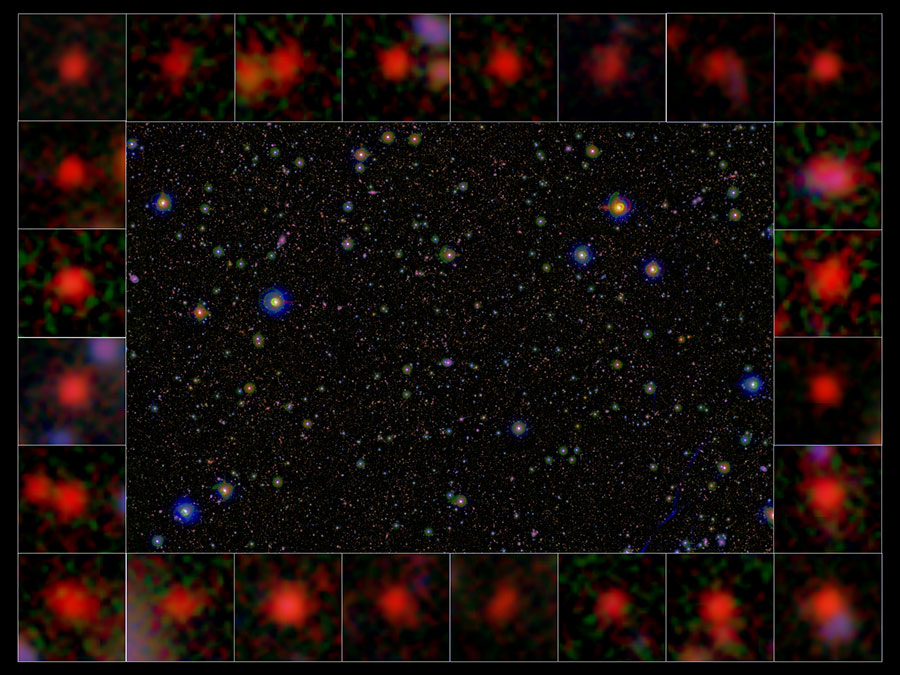
Understanding our place in space is hard, but one factor does make it easier: light travels at a finite speed. From the Sun to the Earth: About eight minutes. From the nearest star to Earth: about 4.4 years. From the most distant galaxy we can see to Earth: 13.4 billion years. That time it takes light to travel means we are always seeing what was, and the further away something is, the farther back in time we’re seeing it.
By looking at collections of galaxies located at similar distances, we can study how the universe looked at different times in history. All those galaxies eight billion light-years away tell us about the universe eight billion years ago. And, in trying to understand how we ended up in a universe full of large elliptical galaxies with no star formation, astronomers looked to the past, to galaxies whose light has traveled from 9.5-12.5 billion years, and looked for the hidden monster that killed star formation.
And they found black holes.
In work appearing in a new paper in The Astrophysical Journal, researchers led by Kei Ito have discovered that star formation in large galaxies ceased around ten billion years ago in response to the light pressure from material falling into these galaxies’ supermassive blackholes. As dust and gas fell in, it was compressed into massive disks that shone brightly. All that light actually produces pressure, and like the pressure of an exhaled breath can push away the dust in the air, the pressure of light can push away the material that would otherwise go on to form stars.
This is an unfortunate case of too much of a good thing; these systems had undergone mergers and rapid star formation, and all this activity is what started dust and gas falling into the galactic cores. There, it lit up and pushed away the material that would have formed new stars, leaving the system dead.
There are monsters out there. Don’t feed them. If you do, they’ll end star formation.
Next up, Beth brings us back to Earth and looks at earthquakes and the Alps before turning to things a bit farther out.

One of my gateways into geology and planetary science was a fascination with earthquakes. As a new resident of California, I was rather fascinated by these events, especially after experiencing a 7.2 my first year here. I’ve always followed the field rather closely, and now, a new study in Nature led by Andrea Licciardi has potentially found a better way to detect earthquakes.
A team of researchers has used a machine-learning algorithm to analyze Global Navigation Satellite System data and find what they refer to as prompt elastogravity signals or PEGS. These are gravitational perturbations that occur during large earthquakes where massive amounts of rock are shifted. And they propagate out at the speed of light, which makes them faster to detect than regular seismic waves.
I want to make it clear that no one is using this data to predict an earthquake. The goal here is to detect quakes as soon as they happen but before the effects are felt by people in order to give communities warning time to prepare for shaking and follow-on effects like tsunamis.
And this model had a response time of about a minute. That means that the magnitude of a massive quake could be determined before the initial shaking has even stopped.
Now, according to the research, this only works on quakes above magnitude 8.3. That may sound like the usefulness is limited, but keep in mind that these immense quakes are the ones that cause the most devastating damage. If we can send out a warning tens of seconds or even minutes earlier than we can now, we could potentially save thousands of lives.
That’s always a worthwhile goal.
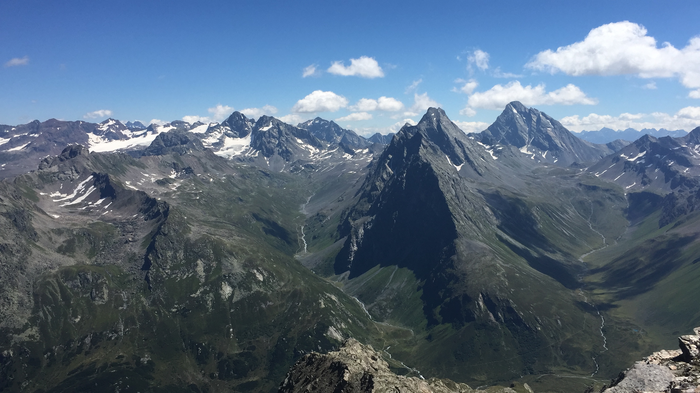
Even though lives aren’t at immediate risk, for the most part, research into the effects of climate change is still a worthwhile endeavor. And a new study published in the journal Science has examined the changes to the biomass in the mountains of the Alps.
While there have been a lot of studies measuring changes to glaciers and snowpack, this study is the first to comprehensively analyze just how much the vegetation in the Alps has increased. The research team used high-resolution satellite data taken from 1984 to 2021 and found that the plant biomass increased above the tree line in over 77% of the areas observed. We’ve seen this greening effect in the Arctic as global temperatures increase, and now we have evidence for the same phenomenon in the continental mountains.
But hey, more plants! That’s cool, right? Vegetation in the Alps is moving into new areas, growing taller, and becoming denser. Which sounds good until you realize that these aren’t necessarily the usual Alpine plants. As lead author Sabine Rumpf explains: Alpine plants are adapted to harsh conditions, but they’re not very competitive. The unique biodiversity of the Alps is therefore under considerable pressure.
In addition to measuring the increase in the vegetation biomass, scientists also analyzed the decrease in the snow cover, not including glaciers and regions below 1,700 meters. The snow cover decreased significantly in about 10% of the area examined. That area may sound like a small amount, but it’s part of a growing trend that is leading to more precipitation which in turn adds to that biomass.
We’re losing bits of white planet for green planet in an increasingly vicious cycle. And this is not good, as Rumpf further explains: Greener mountains reflect less sunlight and therefore lead to further warming – and, in turn, to further shrinkage of reflective snow cover.
Of course, melting glaciers and thawing permafrost create further hazards of landslides and mudflows and impact the availability of drinking water. All of this goes to show that we don’t need an asteroid or an earthquake to threaten life on Earth. Climate change is doing a bang-up job of that already.
That’s enough about Earth for today, I think. Let’s wander further out to our pair of ice giants, Uranus and Neptune.
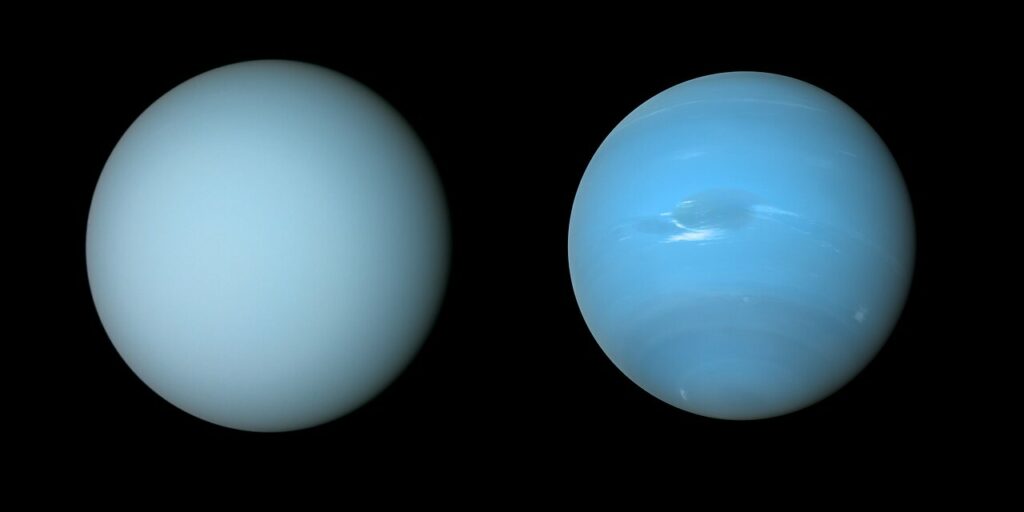
Have you ever noticed that these two planets, so alike in their size and mass, who are also similar in their basic atmospheric compositions, are somehow not the same color? We don’t have many close-up images of the pair, but the most famous pictures come from the Voyager 2 spacecraft. When you see the ice giants side by side, the difference in color is distinct. Neptune is a bright blue orb with noticeable storms; Uranus is a muted, paler blue covered in haze.
The key to that difference is the haze.
In new research published in the Journal of Geophysical Research: Planets and led by Patrick Irwin, observations across ultraviolet, visible, and near-infrared wavelengths were used to model the atmospheric layers of both planets at three different heights. Within those layers, the aerosols were analyzed, and the middle of the three was found to contain the particles causing haze. This particular layer is thicker on Uranus than on Neptune, which could partially explain the haziness differences between the two. Additionally, these aerosols give methane ice a surface onto which to condense, similar to the formation of ammonia mush balls discovered in Jupiter’s atmosphere.
Those bits of ice create a shower of methane snow deep in the atmospheres of the two planets, but then a second difference kicks in. Neptune has a more turbulent atmosphere than Uranus, which makes the brighter blue more apparent as Neptune’s storms churn up the methane particles, thinning out the hazy layer. And voila, but for that turbulence, the two planets would look the same color.
Side note: The effect that makes both of our ice giants look blue is the same that produces blue skies here on Earth – Rayleigh scattering. Methane is good at absorbing the red wavelengths of sunlight, which then leaves behind the predominantly bluer colors seen in the Voyager images.
Okay, NASA. Time for ice giant orbiters, please.
This has been the Daily Space.
You can find more information on all our stories, including images, at DailySpace.org. As always, we’re here thanks to the donations of people like you. If you like our content, please consider joining our Patreon at Patreon.com/CosmoQuestX.
Credits
Written by Pamela Gay, Beth Johnson, Erik Madaus, and Gordon Dewis
Hosted by Pamela Gay, Beth Johnson, and Erik Madaus
Audio and Video Editing by Ally Pelphrey
Content Editing by Beth Johnson
Intro and Outro music by Kevin MacLeod, https://incompetech.com/music/


 We record most shows live, on Twitch. Follow us today to get alerts when we go live.
We record most shows live, on Twitch. Follow us today to get alerts when we go live.